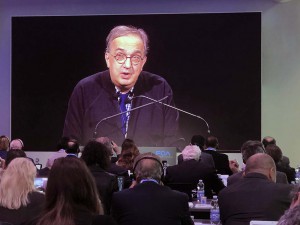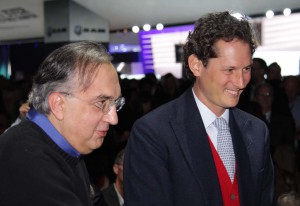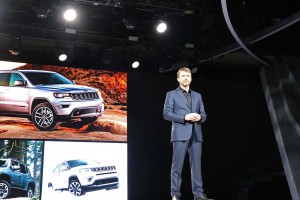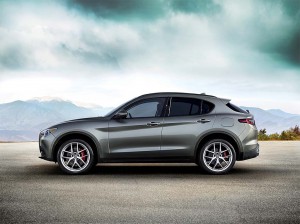Fiat Chrysler Automobiles announced on Saturday that Jeep and Ram brand boss Michael Manley will replace CEO Sergio Marchionne, who due to complications from recent surgery is gravely ill and will not return to work.
Though the 66-year-old Marchionne was known to have undergone surgery this past week for what was reported to be a shoulder problem. According to FCA’s statement, the Italian-born and Canadian-educated Marchionne experienced “unexpected complications,” while his conditions had “worsened significantly in recent hours.”
Word of Marchionne’s departure quickly echoed through the automotive grapevine. Few industry executives have had a higher profile presence in recent decades, and even fewer could be said to have done more to shape a company in his own image as did Marchionne, who rescued the then-bankrupt Chrysler by securing a U.S. government bailout and then merging it with Italy’s Fiat S.p.A.
“For so many, Sergio has been an enlightened leader and a matchless point of reference,” said John Elkann, FCA’s chairman and heir to the Agnelli family that founded Fiat and still holds a controlling stake in the trans-Atlantic automaker. “He taught us that the only question that’s worth asking oneself at the end of every day is whether we have been able to change something for the better, whether we have been able to make a difference.”
(Just four brands will dominate the future for FCA. Click Here to learn more.)
A brilliant strategist, Marchionne was born in a Abruzzo, Italy and migrated with his family to Toronto when he was 13. He earned degrees at the University of Toronto and later at the University of Windsor, a tunnel or bridge ride away from Detroit. While not an automotive “lifer,” he was brought on by Fiat in May 2003 and then was named its CEO the following year.
The Italian automaker faced serious problems at the time but Marchionne won kudos for quickly improving its fortunes, quickly proving himself “an extraordinarily dynamic individual, with quite a lot of energy,” said David Cole, the director-emeritus of the Center for Automotive Research in Ann Arbor, Michigan.
But the real test would come in 2009, as the Great Recession struck the auto industry, driving two of Detroit’s Big Three into bankruptcy. While then-president Obama was ready to bail out General Motors he considered letting Chrysler go under – until Marchionne came along as the U.S. automaker’s white knight. What started as a Euro-American alliance eventually resulted in a formal merger and, proving his energy level never flagged, Marchionne routinely commuted between corporate offices in Italy, the Detroit suburbs and London, where FCA is legally headquartered.
There is little doubt the company is in far better shape than when he stepped in to save Chrysler. In June, at a corporate strategy conference called to outline latest FCA’s 5-year plan, Marchionne declared meeting one of his most critical goals: eliminating the company’s industrial debt. Only two months earlier, Marchionne was able to announce a record first-quarter profit of $1.24 billion.
Much of that credit goes to just two brands: Jeep and Ram, beneficiaries of the massive shift from traditional passenger cars to light trucks. Since the two sides of FCA came together, Jeep has shifted from a largely American-based brand into a global powerhouse, sales roughly tripling to around 2 million SUVs a year. Ram, while remaining more U.S.-centric, nonetheless has challenged bigger brands like Ford and Chevrolet and now generates the bulk of Fiat Chrysler’s global revenue.
New CEO Manley built his own reputation on his work at Jeep, which he’s run since 2009 and, later, Jeep. The 54-year-old British native – who originally joined the old DaimlerChrysler in 2000, surviving its break-up and the subsequent bankruptcy – was a key architect of the new five-year plan outlined in Milan nearly two months ago.
The plan was not quite as well-received by Wall Street as FCA executives had hoped, said analyst Joe Phillippi, of AutoTrends Consulting. And, even before Marchionne’s surgery, that triggered concerns he might have lost some support from the Agnelli family. “They may not have been happy that the street said ‘ho-hum.’”
FCA Chairman Elkann’s lengthy tribute statement appears aimed at dismissing any speculation that Marchionne was forced out, however.
While there is no doubt the now-former CEO made a number of critical steps while at the FCA helm, his work was far from complete. Though Marchionne hasn’t said much about the topic of late, he spent much of his years as chief executive trying to hunt down an alliance or merger partner that could increase FCA’s economies of scale and pump in both cash and technological help.
(What’s Fiat Chrysler Automobiles without a Fiat or a Chrysler? Click Here to see what their (diminished) roles will be.)
One of the big challenges facing Manley will be to position FCA as a player, rather than a laggard, in the critical areas of autonomous driving and electrification. His former boss did take a few steps, launching a plug-in hybrid version of the Chrysler Pacifica minivan and doing a deal to sell more than 60,000 of those hybrid vans to self-driving tech leader Waymo. Meanwhile, two of FCA’s European brands, Alfa Romeo and Maserati now plan to electrify large chunks of their product lines.
Along with Jeep and Ram, Alfa and Maserati were identified in the Milan meeting as central to FCA’s global ambitions. But they have a lot to do to live up to expectations. “On the negative side, (Marchionne) burned a lot of cash trying to revive Alfa Romeo and it’s still a work in progress,” said Phillippi.
While Maserati, the more luxurious of the two brands, has been gaining traction, especially since it launched its first SUV, Alfa has struggled, sales currently lagging well behind what was outlined in Marchionne’s previous five-year plan.
“The original five-year plan wasn’t wrong,” Alfa and Maserati brand chief Tim Kuniskis said during an interview with NBC last month. “We said we’d sell 400,000 (Alfas a year) and we will. It’s just taking longer to get there,” in part, he said, because Alfa has shifted product plans to emphasize SUVs, rather than sedans, reflecting global market trends.
The new plan surprised some observers with the strategy of all but dismissing FCA’s two marquee brands. But marchionne insisted that while the Fiat and Chrysler badges will shrink in importance they will remain part of the corporate portfolio, as will Dodge, which will put even more emphasis on building American-style muscle cars.
(Click Here to check out the 10,000 hp version of the Dodge Charger Hellcat.)
Whether Manley will make any moves away from the strategies outlined by his former boss will likely take some time to play out. He was widely seen as Marchionne’s heir-apparent, but he also was expected to retain his post helming Jeep and Ram for nearly another year. While he had a strong input into the five-year plan, Manley will now have to take ownership of it.




